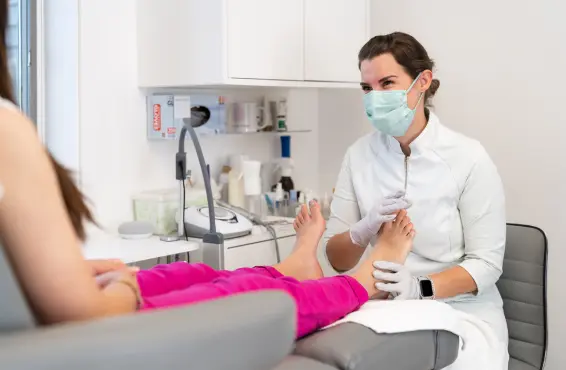Ever woken up to that stabbing sensation in your heel? Or noticed that bump on your big toe getting larger and more painful? You’re not alone. Foot pain affects millions of Americans daily, disrupting simple activities we often take for granted. Plantar fasciitis impacts more than 1 million people worldwide annually, with a lifetime prevalence that may reach 10% of the general population.
The good news? Most foot conditions respond exceptionally well to proper treatment from qualified professionals who understand the complexities of foot mechanics.
Understanding Heel Pain: Causes and Symptoms
When heel pain strikes, it can transform simple activities like walking to the kitchen for morning coffee into painful ordeals. Understanding what’s happening in your feet is the first step toward finding relief.
Common Types of Heel Pain Conditions
Plantar fasciitis tops the list as the most common source of heel pain. This condition involves inflammation of the thick band of tissue (plantar fascia) that runs across the bottom of your foot, connecting your heel bone to your toes. When this tissue becomes irritated and swollen, every step can feel like walking on broken glass.
Heel spurs often develop alongside plantar fasciitis. These bony growths form on the underside of the heel bone, frequently causing sharp, stabbing heel pain when bearing weight.
Achilles tendinitis affects the tendon connecting your calf muscles to your heel bone, typically causing pain at the back rather than underneath the heel.
Recognizing Heel Pain Warning Signs
Morning pain offers one of the most telling clues about your heel condition. If those first steps out of bed feel excruciating, plantar fasciitis might be the culprit. This distinctive pattern, severe pain after periods of rest that temporarily improves with movement, is a key diagnostic indicator.
Pain that worsens during the day, especially after long periods of standing or activity, suggests your body needs attention. Don’t ignore persistent swelling or tenderness that doesn’t improve with rest.
Risk Factors That Contribute to Heel Pain
Your shoe choices significantly impact foot health. A study of healthcare workers found that high heel standing was uncomfortable for 54.5% of participants. Consistently wearing unsupportive footwear creates a perfect storm for developing heel pain.
Age plays a role too, as the protective fat pad on your heel naturally thins over time. Weight also matters, each extra pound adds significant pressure to your feet with every step. Finding a qualified podiatrist near me can help address these factors before they cause serious damage.
Bunions Demystified: More Than Just a Bump
Many dismiss bunions as merely cosmetic concerns, but these joint deformities can significantly impact your quality of life if left untreated.
A bunion (hallux valgus) forms when the joint at the base of your big toe becomes misaligned. Over time, the toe gradually shifts toward the smaller toes while the joint at the base protrudes outward. This represents a fundamental change in the structure of your foot.
As the deformity progresses, the toe can overlap with neighboring toes, creating additional problems like hammertoes or corns. Bunionettes, sometimes called “tailor’s bunions,” develop on the outside of the foot at the base of the little toe.
Early Signs of Bunion Development
Catching bunions early provides more treatment options. Watch for a visible bulge at the base of your big toe, especially one that seems to be growing larger. You might notice redness, swelling, or calluses developing at the site.
Bunion pain often begins as intermittent discomfort that worsens with certain shoes. Many patients report pain that fluctuates, sometimes barely noticeable, other times sharp and limiting.
Causes Behind Bunion Formation
Heredity plays a significant role, if your parents had bunions, you’re at higher risk. But footwear choices dramatically influence bunion development and progression. This is one reason women are 10 times more likely to develop bunions.
Certain foot types, particularly those with low arches or flat feet, face an increased risk. Inflammatory conditions like rheumatoid arthritis can also contribute to bunion formation through joint deterioration.
Professional Diagnosis: Why Expert Assessment Matters
While online symptom checkers might point you in the right direction, nothing replaces professional evaluation for foot conditions. Accurate diagnosis forms the foundation for effective treatment.
Advanced Diagnostic Techniques for Foot Conditions
Modern podiatry utilizes sophisticated tools to analyze your foot structure and movement patterns. Computerized gait analysis can reveal biomechanical issues that contribute to your pain. Advanced imaging, including weight-bearing X-rays, provides critical information about bone alignment and joint spacing.
Pressure mapping technology creates a detailed picture of how weight distributes across your feet when standing and walking, highlighting areas of excessive stress that need addressing.
What to Expect During Your First Podiatry Visit
Your initial appointment will include a comprehensive foot examination, where the doctor will assess your foot structure, flexibility, and areas of tenderness. Be ready to discuss your medical history, including past injuries and family patterns of foot problems.
Your podiatrist will observe your walking pattern and evaluate your current footwear for wear patterns. This detailed assessment helps develop a treatment plan tailored specifically to your needs and lifestyle.
Effective Heel Pain Treatment Options
Most heel pain responds well to targeted interventions, especially when treatment begins early. Your podiatrist will likely recommend a combination of approaches.
Conservative Approaches for Immediate Relief
Simple modifications often produce significant improvement. Specific stretching exercises targeting the plantar fascia and Achilles tendon can reduce tension and pain. Temporary activity adjustments help inflamed tissues heal.
Ice therapy reduces inflammation when applied correctly, typically 15-20 minutes several times daily. Over-the-counter anti-inflammatory medications may provide temporary relief, though they address symptoms rather than underlying causes.
Custom Orthotics for Heel Pain Management
Custom orthotics provide targeted support exactly where your feet need it. Unlike one-size-fits-all inserts from drugstores, prescription orthotics address your specific foot mechanics and condition.
These devices redistribute pressure away from painful areas while supporting structures like the arch. Many patients report significant foot pain relief within weeks of consistent orthotic use.
Advanced Therapies for Persistent Heel Pain
For stubborn cases, your podiatrist may recommend specialized treatments like extracorporeal shockwave therapy (ESWT), which uses sound waves to stimulate healing in damaged tissue. Platelet-rich plasma (PRP) injections harness your body’s natural healing factors to accelerate recovery.
Corticosteroid injections can provide temporary relief but are typically used sparingly due to potential side effects with repeated use.
Comprehensive Bunion Treatment Solutions
Bunions treatment spans a spectrum from conservative management to surgical correction, depending on severity and symptoms.
Non-Surgical Bunion Management
Conservative approaches focus on relieving pressure and slowing progression. Toe spacers and bunion pads create breathing room in shoes. Night splints help maintain proper toe alignment during sleep.
Proper footwear selection is crucial, shoes with wide toe boxes and good arch support minimize bunion irritation. Physical therapy exercises can improve joint mobility and strengthen surrounding muscles.
When Is Bunion Surgery Necessary?
Surgery becomes an option when conservative measures fail to provide adequate relief. Modern surgical techniques have advanced significantly, with some offering impressive outcomes. The Lapiplasty technique boasts a 99% success rate with the bunion never returning.
Minimally invasive procedures allow for smaller incisions and faster recovery times. Your surgeon will recommend the most appropriate technique based on your specific deformity and lifestyle needs.
Post-Treatment Care for Optimal Results
Follow-up care proves essential for long-term success. Your podiatrist will guide you through a rehabilitation program to restore strength and flexibility. Preventing recurrence requires ongoing attention to footwear choices and possibly continued orthotic use.
Your Path to Pain-Free Steps
Living with heel pain or bunion pain isn’t something you have to accept. Today’s advanced podiatric care offers numerous effective solutions tailored to your specific condition and needs. The journey to comfort begins with finding the right professional partner for your foot health.
Remember that foot pain serves as your body’s warning system, ignoring it rarely leads to improvement. Taking that first step in seeking qualified care makes all the difference in regaining pain-free mobility and preventing future complications. Your feet carry you through life, they deserve expert attention when problems arise.
Questions About Heel Pain and Bunions
Will my heel pain go away on its own?
While minor, recent heel pain might resolve with rest and home care, persistent pain lasting more than a week typically requires professional treatment. Ignoring ongoing heel pain often leads to compensation patterns that create additional problems throughout your body.
Can bunions be reversed without surgery?
Non-surgical treatments can effectively manage bunion pain and may slow progression, but they cannot reverse the structural bone changes that have already occurred. Early intervention offers the best chance to prevent worsening deformity.
How long can you expect to recover from bunion surgery?
Recovery timelines vary based on the surgical technique and individual healing factors. Most patients can bear weight in a surgical boot within 1-2 weeks, wear regular shoes around 6-8 weeks, and return to full activities within 3-4 months.
Also Read-Breathe Easy? Understanding Vaping and Lung Health


